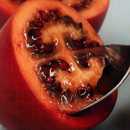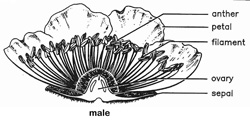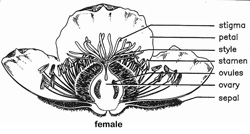|

Kiwifruit Female - Hayward, Male - Toumuri
Female flowers many creamy styles growing from a swollen ovary. Male flowers are usually smaller with many long stamens. Bees are the pollinators.A berry the shape and size of a large hens egg, covered with a distinctive, thin, brown fuzzy skin. Inside are many, very small, black edible seeds that are embedded in vibrant emerald green flesh. This fruit does not degrade as they ripen. The flesh is firm with a tangy acid bit becoming sweet and soft.
Habit - Forms extremely vigorous and long-lived vines. Produces two types of shoots terminating and non-terminating. Terminating shoots are shorter, with only 3-6 leaves and usually form flower buds the following year. Non-terminating shoots can grow 3-5 m long in a single season, have smaller leaves and stem tips coil around structures they come in contact with. Tie vines securely to its supporting wires. Never twist around the wires as the vine tends to strangle itself or on very hot days the wire will burn through the branch.
Size - Can grow to 6-8m wide by 3-4m tall.
Pollination - Bees are the usual pollinators, but then aren't very attracted to the flowers, as the flowers do not have any nectar. So the presence of a nearby hive or hand pollination can increase fruit set and size.
Male - Chiefton - is a pollinator only.
Female - Hayward
Plant in a ratio of 1 male to 5 female plants.
Harvest - Fruit ripens in late autumn to early winter, usually just before the leaf drop. Pick largest fruit first allowing the rest to continue maturation. Usually the longer on the vine the sweeter the fruit will become. Can be harvested when under ripe and will ripen if kept at room temperature for a couple of days. Vines can be over productive and may need some fruit thinning to avoid biennial bearing and to even out yields.
Variety Fruiting Time
|





